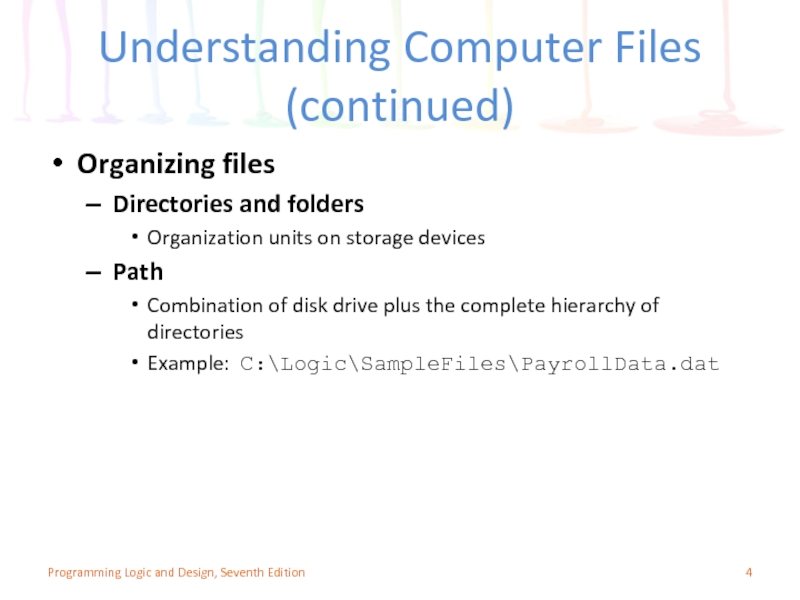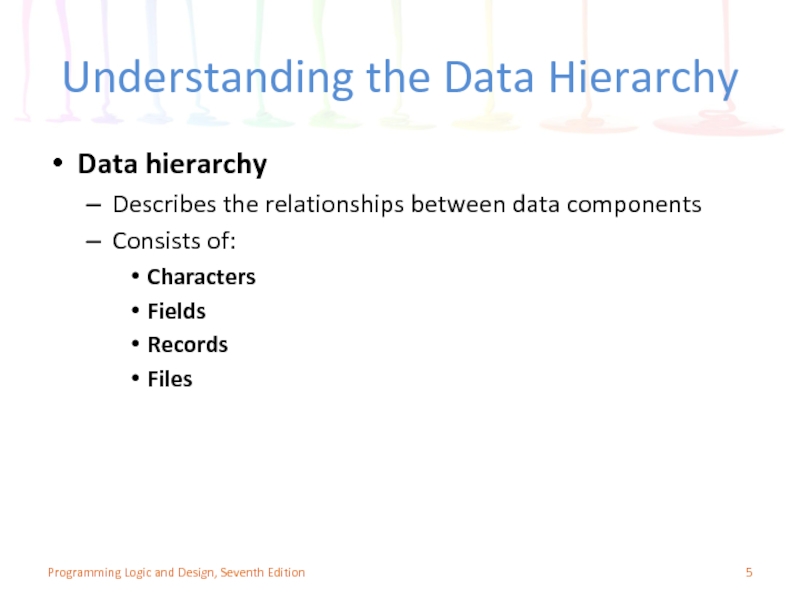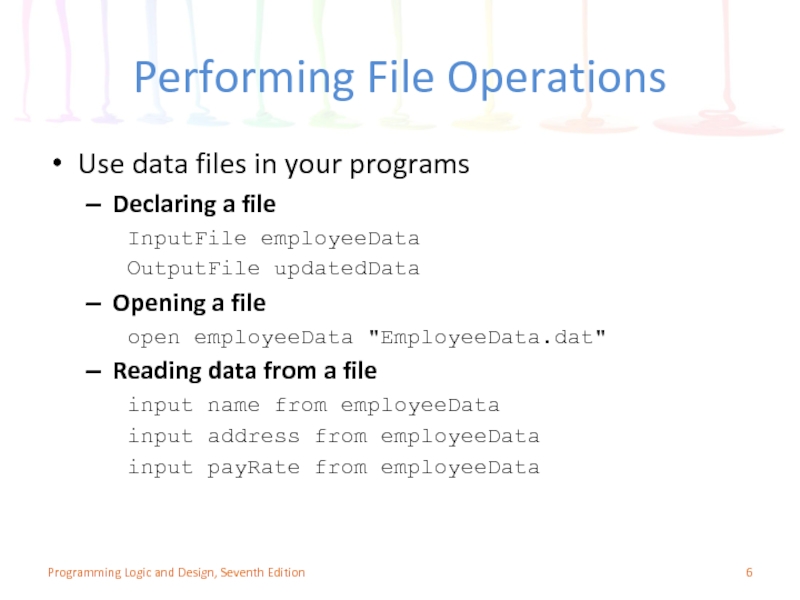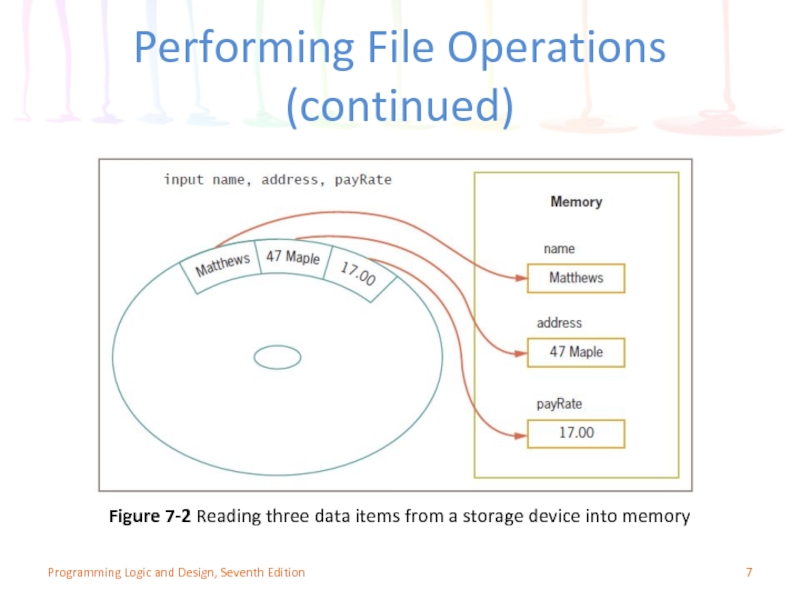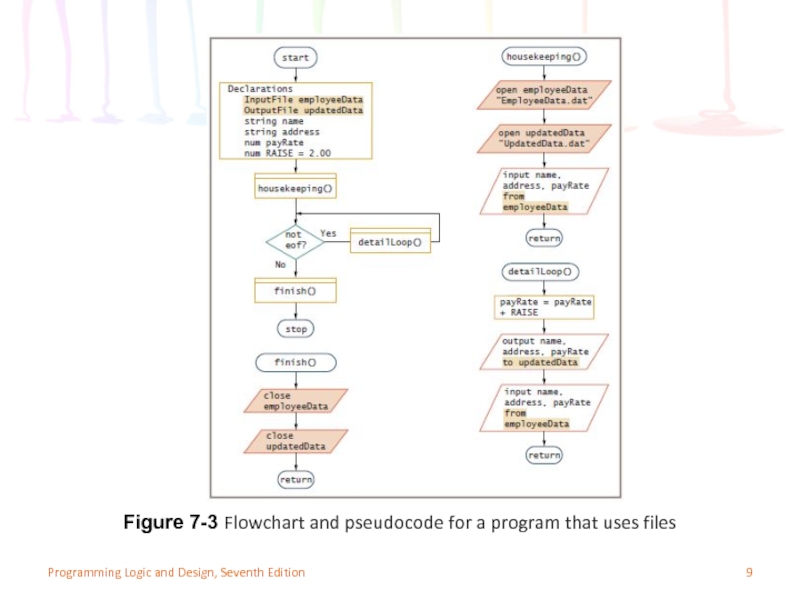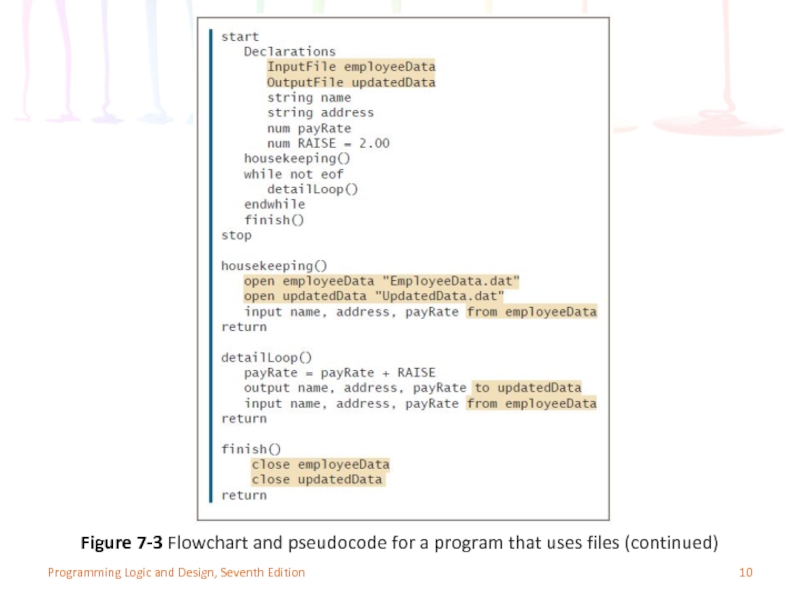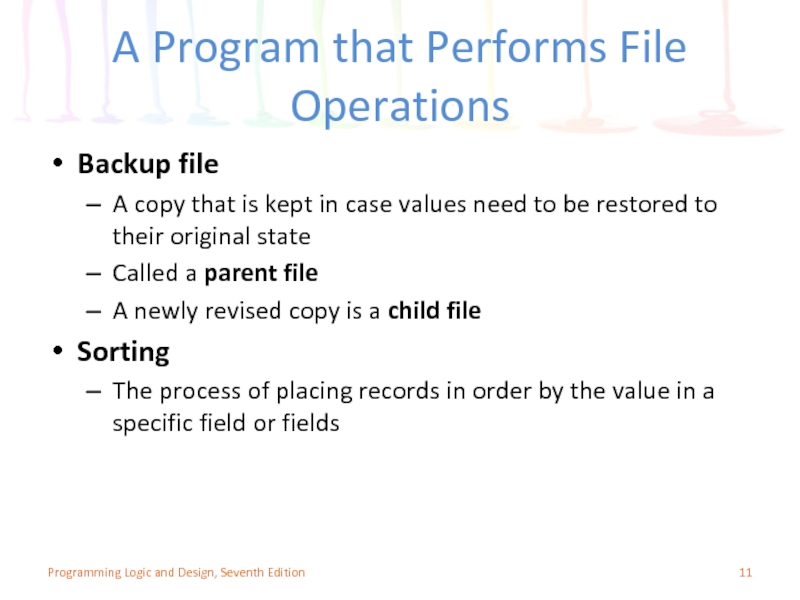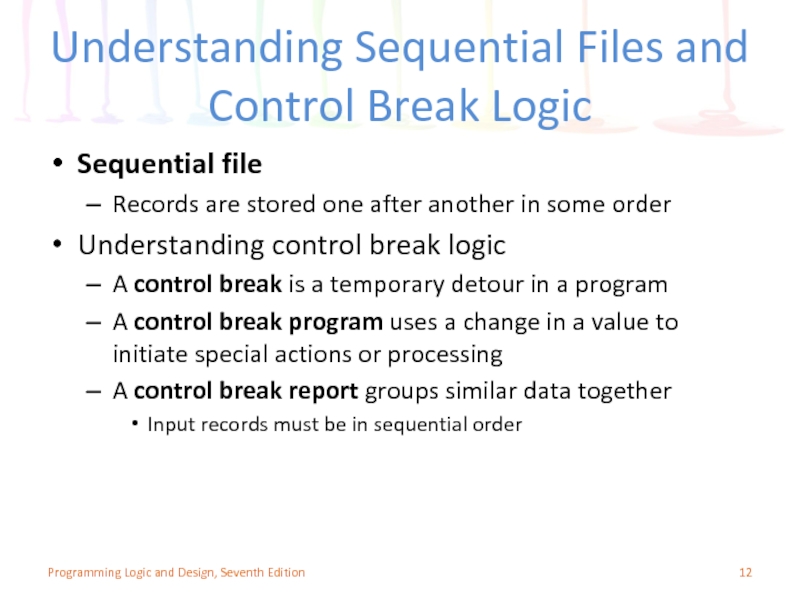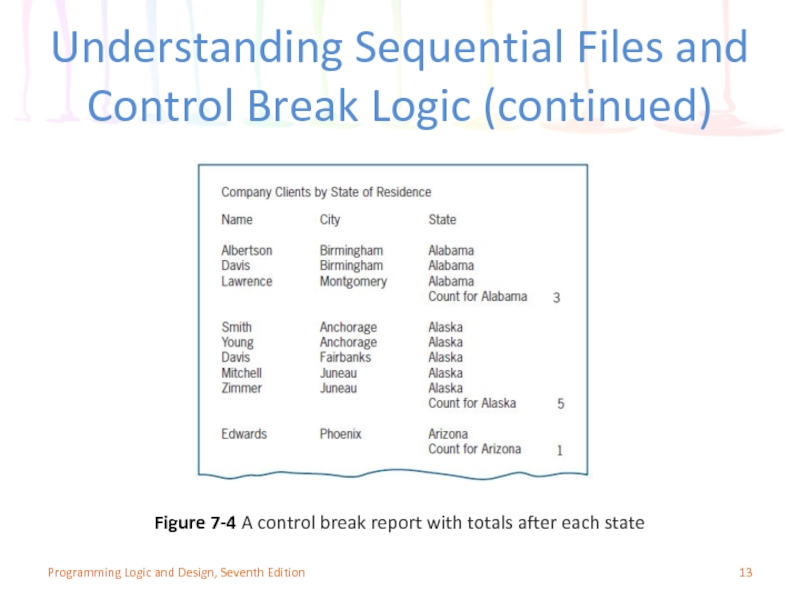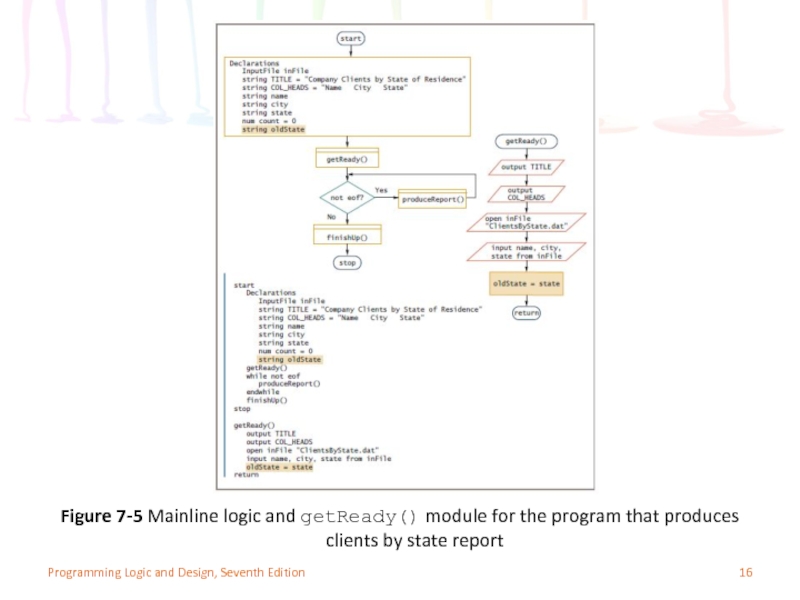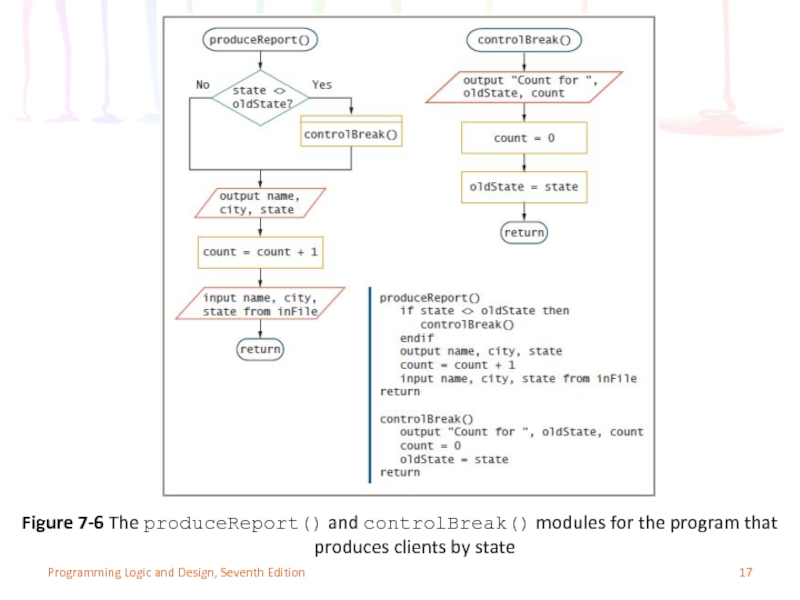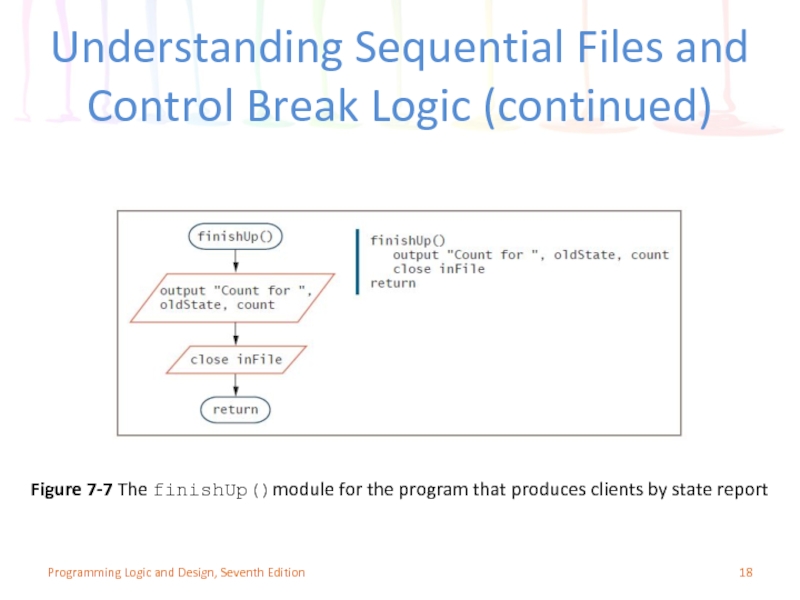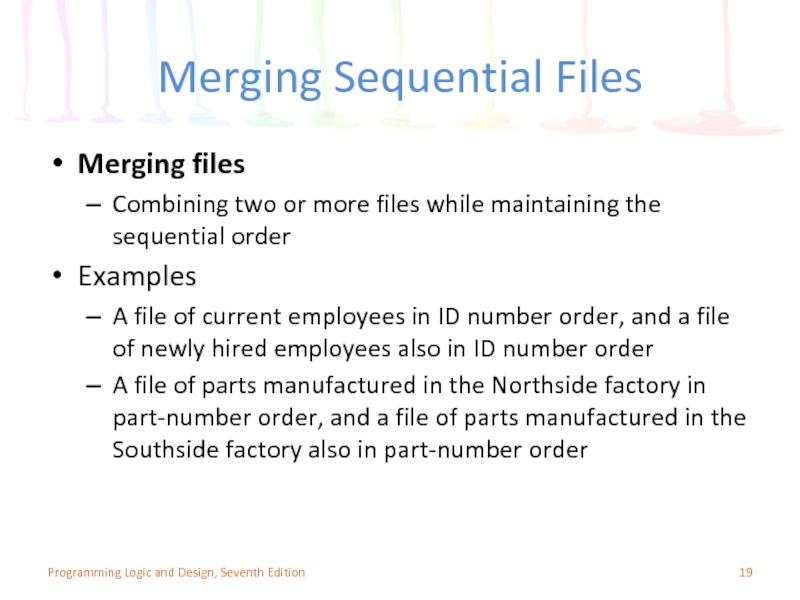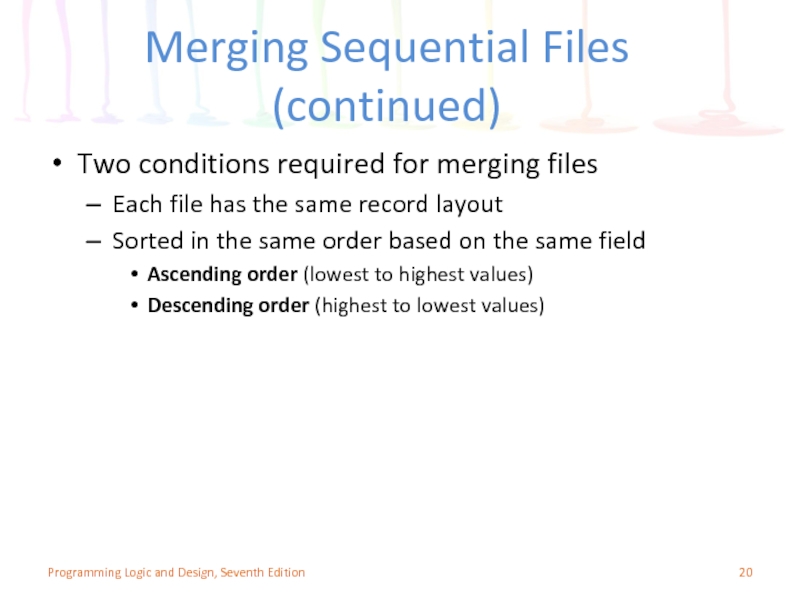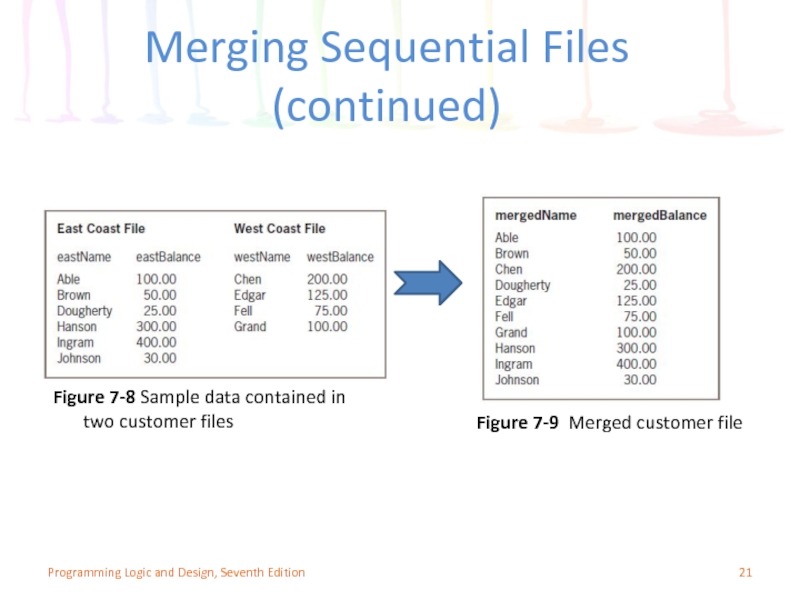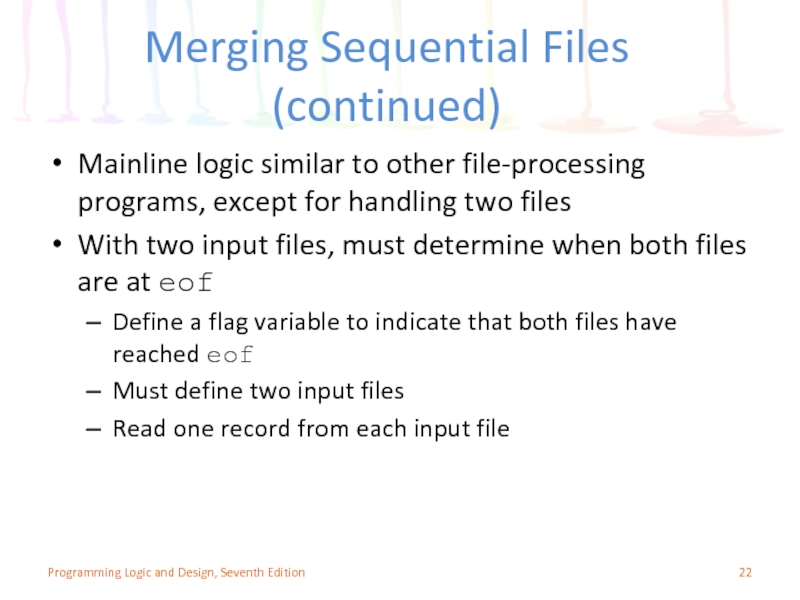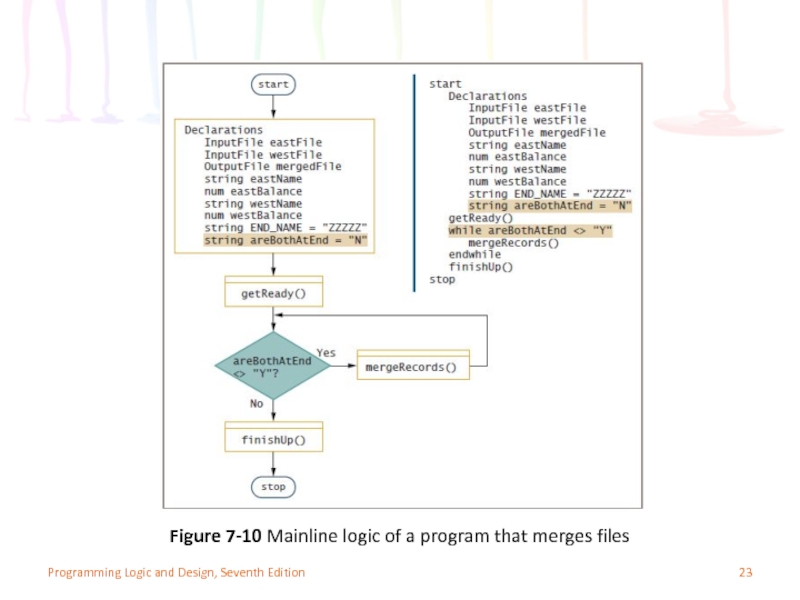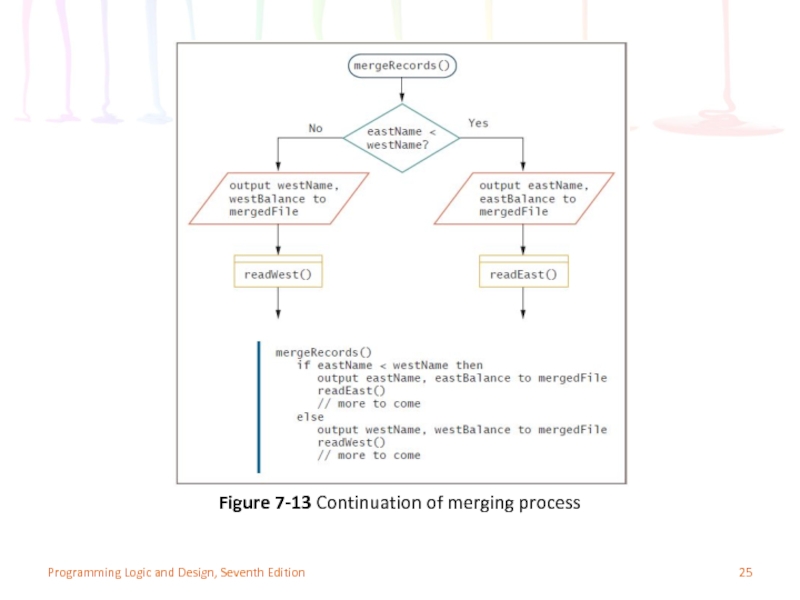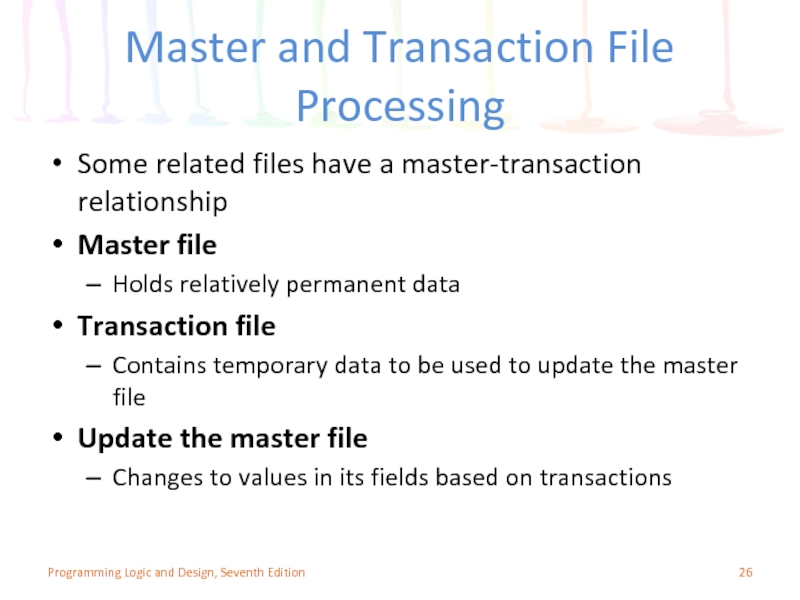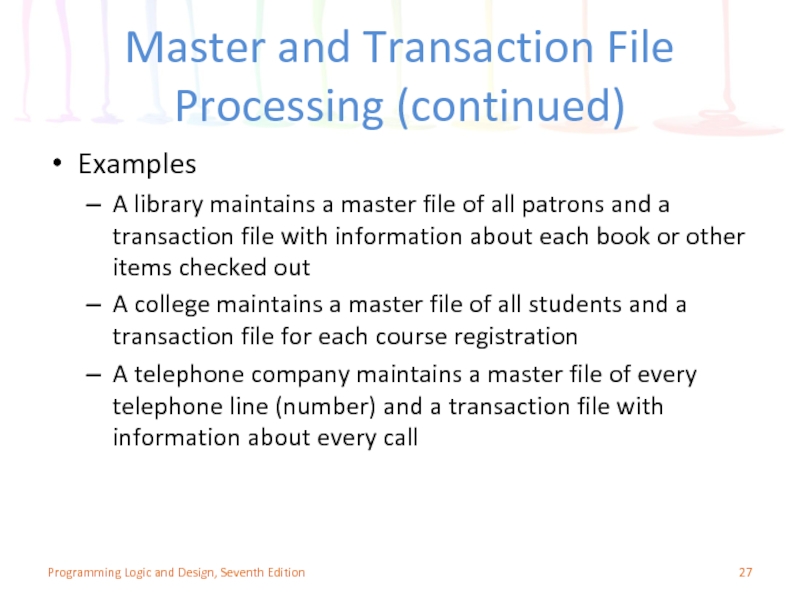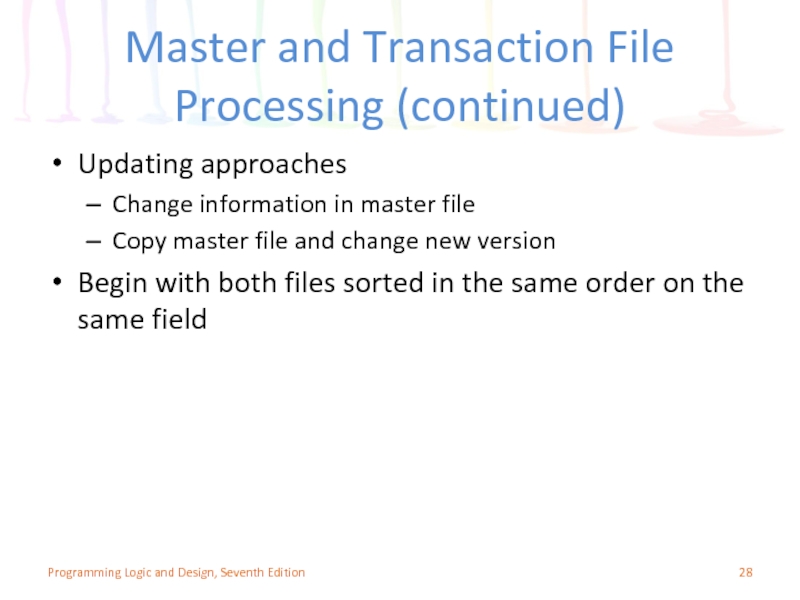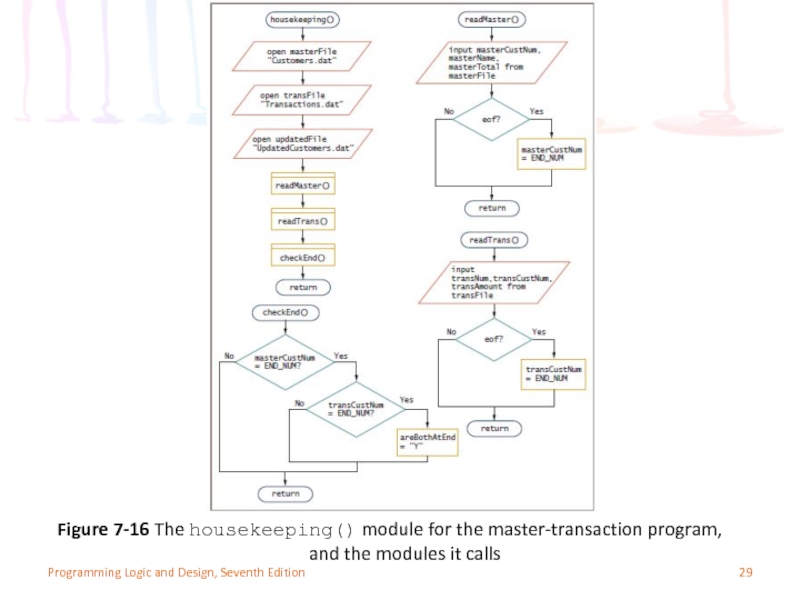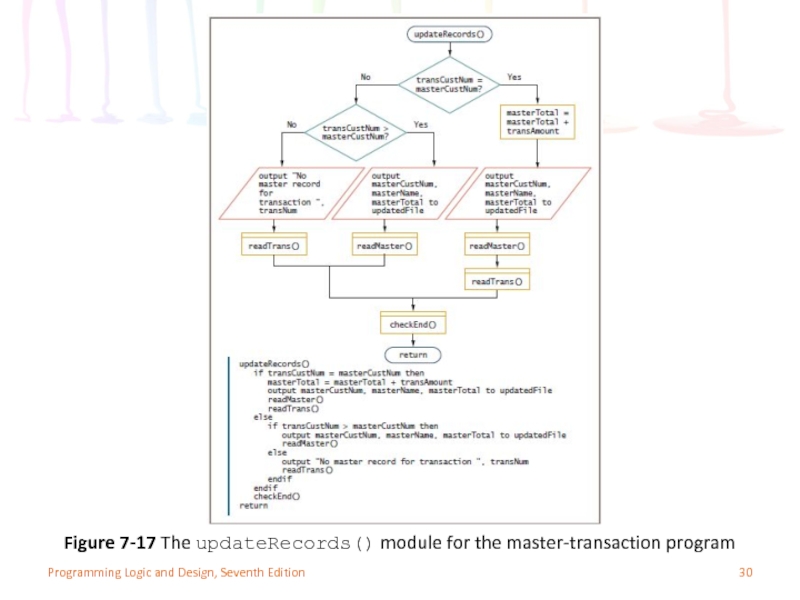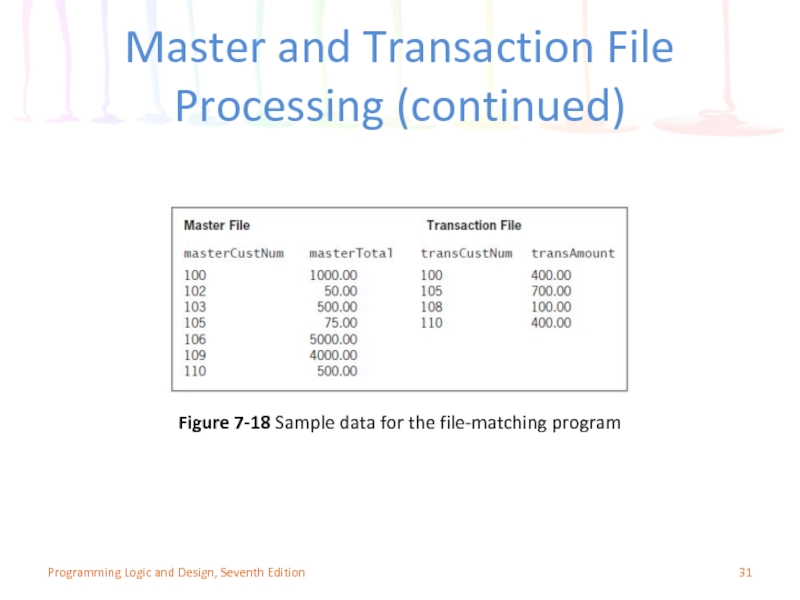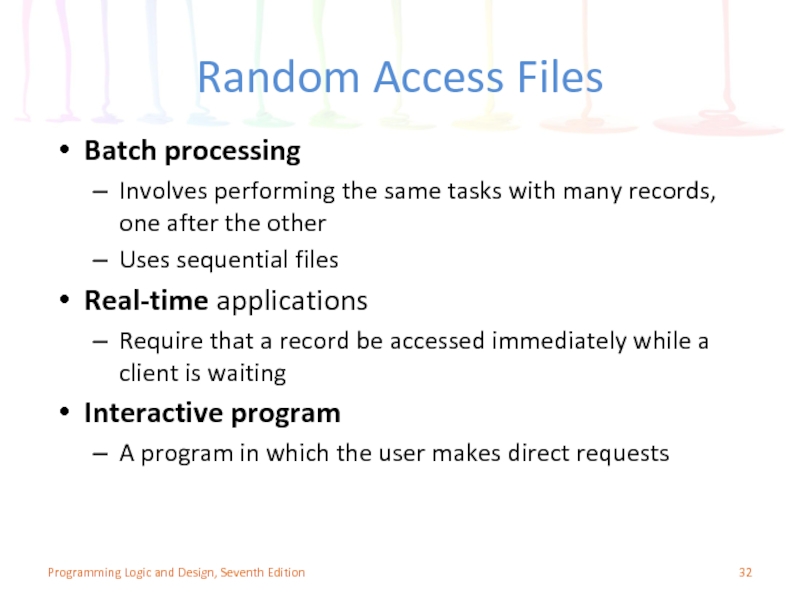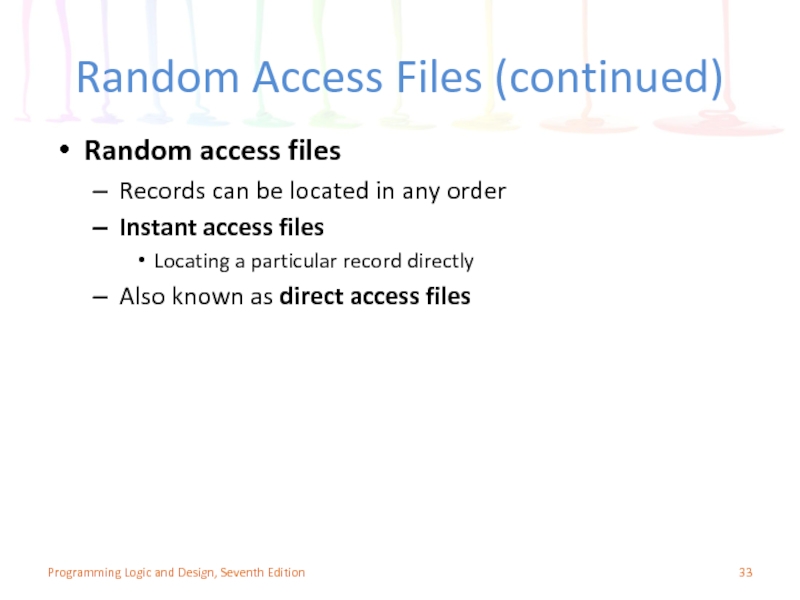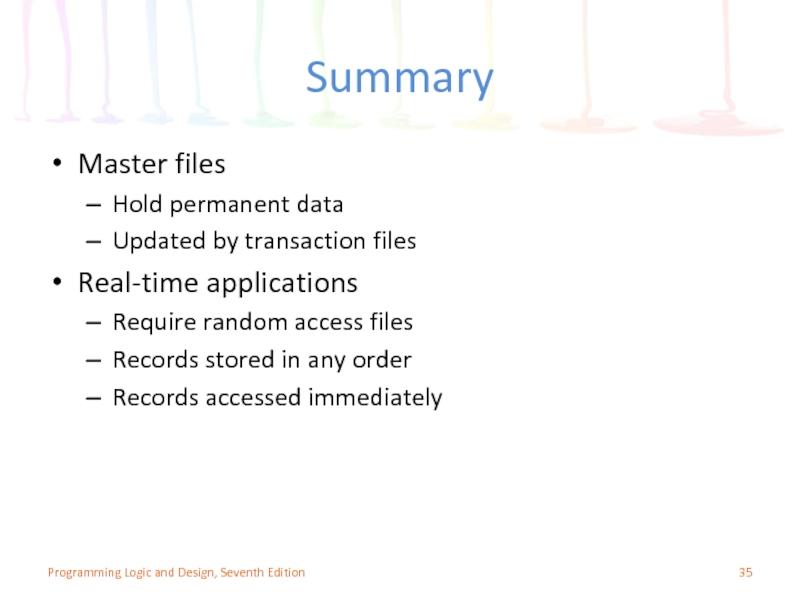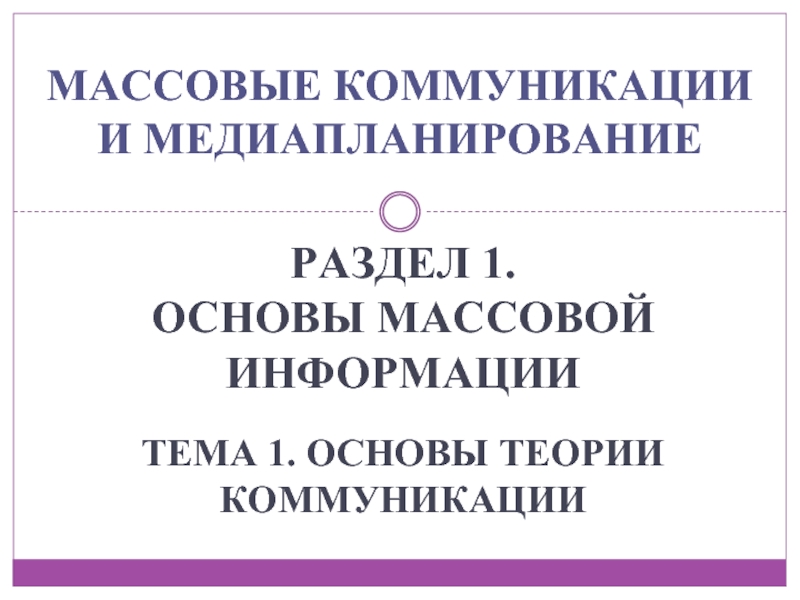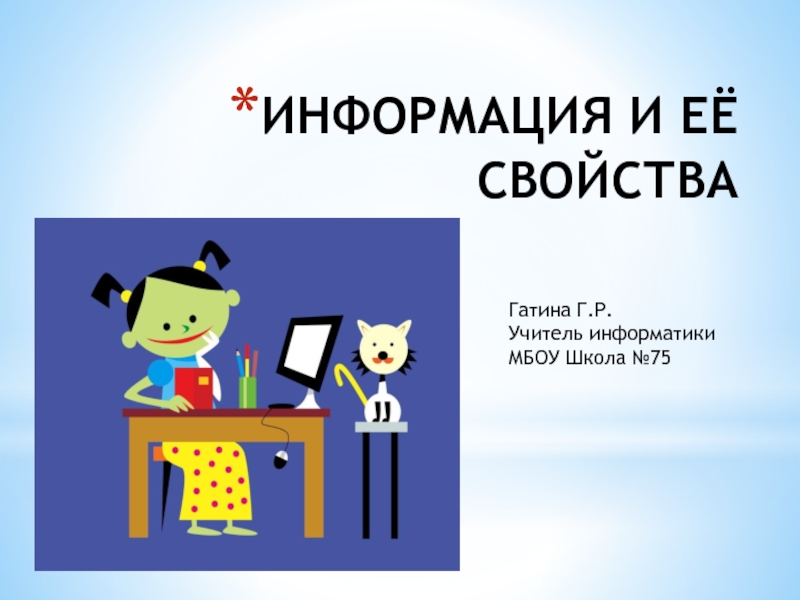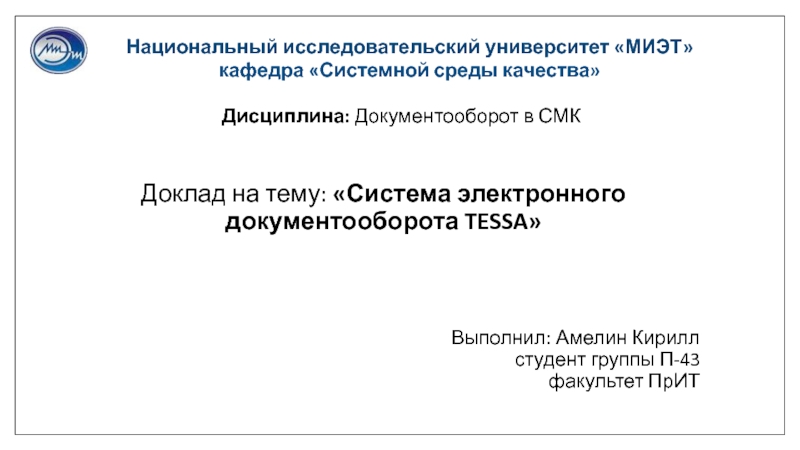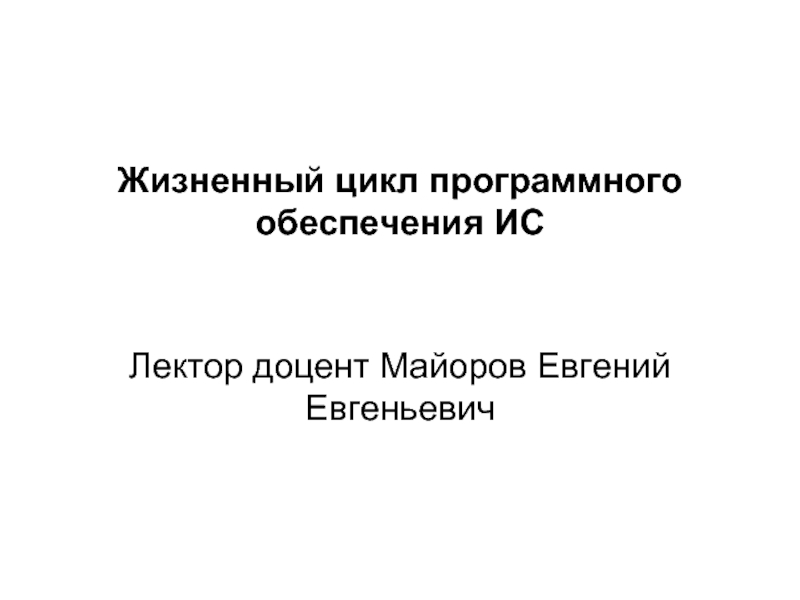- Главная
- Разное
- Дизайн
- Бизнес и предпринимательство
- Аналитика
- Образование
- Развлечения
- Красота и здоровье
- Финансы
- Государство
- Путешествия
- Спорт
- Недвижимость
- Армия
- Графика
- Культурология
- Еда и кулинария
- Лингвистика
- Английский язык
- Астрономия
- Алгебра
- Биология
- География
- Детские презентации
- Информатика
- История
- Литература
- Маркетинг
- Математика
- Медицина
- Менеджмент
- Музыка
- МХК
- Немецкий язык
- ОБЖ
- Обществознание
- Окружающий мир
- Педагогика
- Русский язык
- Технология
- Физика
- Философия
- Химия
- Шаблоны, картинки для презентаций
- Экология
- Экономика
- Юриспруденция
Programming Logic and Design. Chapter 7. File Handling and Applications презентация
Содержание
- 1. Programming Logic and Design. Chapter 7. File Handling and Applications
- 2. Objectives In this chapter, you will learn
- 3. Understanding Computer Files Computer file A collection
- 4. Understanding Computer Files (continued) Organizing files Directories
- 5. Understanding the Data Hierarchy Data hierarchy Describes
- 6. Performing File Operations Use data files in
- 7. Performing File Operations (continued) Programming Logic and
- 8. Performing File Operations (continued) Writing data to
- 9. Figure 7-3 Flowchart and pseudocode for a
- 10. Figure 7-3 Flowchart and pseudocode for a
- 11. A Program that Performs File Operations Backup
- 12. Understanding Sequential Files and Control Break Logic
- 13. Understanding Sequential Files and Control Break Logic
- 14. Understanding Sequential Files and Control Break Logic
- 15. Understanding Sequential Files and Control Break Logic
- 16. Programming Logic and Design, Seventh Edition Figure
- 17. Programming Logic and Design, Seventh Edition Figure
- 18. Programming Logic and Design, Seventh Edition Figure
- 19. Merging Sequential Files Merging files Combining two
- 20. Merging Sequential Files (continued) Two conditions required
- 21. Merging Sequential Files (continued) Figure 7-8 Sample
- 22. Mainline logic similar to other file-processing programs,
- 23. Programming Logic and Design, Seventh Edition Figure
- 24. Programming Logic and Design, Seventh Edition Figure 7-12 Start of merging process
- 25. Programming Logic and Design, Seventh Edition Figure 7-13 Continuation of merging process
- 26. Master and Transaction File Processing Some related
- 27. Master and Transaction File Processing (continued) Examples
- 28. Master and Transaction File Processing (continued) Updating
- 29. Figure 7-16 The housekeeping() module for the
- 30. Figure 7-17 The updateRecords() module for the master-transaction program Programming Logic and Design, Seventh Edition
- 31. Master and Transaction File Processing (continued) Programming
- 32. Random Access Files Batch processing Involves performing
- 33. Random Access Files (continued) Random access files
- 34. Summary Computer file A collection of data
- 35. Summary Master files Hold permanent data Updated
Слайд 2Objectives
In this chapter, you will learn about:
Computer files
The data hierarchy
Performing file
Sequential files and control break logic
Merging files
Master and transaction file processing
Random access files
Programming Logic and Design, Seventh Edition
Слайд 3Understanding Computer Files
Computer file
A collection of data stored on permanent storage
Text files (numbers, names, salaries) that can be read by a text editor
Binary files (images and music)
File size measured in bytes
Byte (one character), kilobyte (thousands of bytes), megabyte (millions of bytes), gigabyte (billions of bytes), terabyte (trillions of bytes)
Programming Logic and Design, Seventh Edition
Слайд 4Understanding Computer Files (continued)
Organizing files
Directories and folders
Organization units on storage devices
Path
Combination
Example: C:\Logic\SampleFiles\PayrollData.dat
Programming Logic and Design, Seventh Edition
Слайд 5Understanding the Data Hierarchy
Data hierarchy
Describes the relationships between data components
Consists of:
Characters
Fields
Records
Files
Programming Logic and Design, Seventh Edition
Слайд 6Performing File Operations
Use data files in your programs
Declaring a file
InputFile employeeData
OutputFile
Opening a file
open employeeData "EmployeeData.dat"
Reading data from a file
input name from employeeData
input address from employeeData
input payRate from employeeData
Programming Logic and Design, Seventh Edition
Слайд 7Performing File Operations (continued)
Programming Logic and Design, Seventh Edition
Figure 7-2 Reading
Слайд 8Performing File Operations (continued)
Writing data to a file
output name, address, payRate
Closing a file
Always close every file you open
Programming Logic and Design, Seventh Edition
Слайд 9Figure 7-3 Flowchart and pseudocode for a program that uses files
Programming
Слайд 10Figure 7-3 Flowchart and pseudocode for a program that uses files
Programming Logic and Design, Seventh Edition
Слайд 11A Program that Performs File Operations
Backup file
A copy that is
Called a parent file
A newly revised copy is a child file
Sorting
The process of placing records in order by the value in a specific field or fields
Programming Logic and Design, Seventh Edition
Слайд 12Understanding Sequential Files and Control Break Logic
Sequential file
Records are stored one
Understanding control break logic
A control break is a temporary detour in a program
A control break program uses a change in a value to initiate special actions or processing
A control break report groups similar data together
Input records must be in sequential order
Programming Logic and Design, Seventh Edition
Слайд 13Understanding Sequential Files and Control Break Logic (continued)
Programming Logic and Design,
Figure 7-4 A control break report with totals after each state
Слайд 14Understanding Sequential Files and Control Break Logic (continued)
Programming Logic and Design,
Examples of control break reports
All employees listed in order by department number, with a new page started for each department
All books for sale in a bookstore listed in order by category (such as reference or self-help), with a count following each category of book
All items sold in order by date of sale, with a different ink color for each new month
Слайд 15Understanding Sequential Files and Control Break Logic (continued)
Single-level control break
A detour
Uses a control break field to hold the previous value
Programming Logic and Design, Seventh Edition
Слайд 16Programming Logic and Design, Seventh Edition
Figure 7-5 Mainline logic and getReady()
Слайд 17Programming Logic and Design, Seventh Edition
Figure 7-6 The produceReport() and controlBreak()
Слайд 18Programming Logic and Design, Seventh Edition
Figure 7-7 The finishUp()module for the
Understanding Sequential Files and Control Break Logic (continued)
Слайд 19Merging Sequential Files
Merging files
Combining two or more files while maintaining the
Examples
A file of current employees in ID number order, and a file of newly hired employees also in ID number order
A file of parts manufactured in the Northside factory in part-number order, and a file of parts manufactured in the Southside factory also in part-number order
Programming Logic and Design, Seventh Edition
Слайд 20Merging Sequential Files (continued)
Two conditions required for merging files
Each file has
Sorted in the same order based on the same field
Ascending order (lowest to highest values)
Descending order (highest to lowest values)
Programming Logic and Design, Seventh Edition
Слайд 21Merging Sequential Files (continued)
Figure 7-8 Sample data contained in two customer
Programming Logic and Design, Seventh Edition
Figure 7-9 Merged customer file
Слайд 22Mainline logic similar to other file-processing programs, except for handling two
With two input files, must determine when both files are at eof
Define a flag variable to indicate that both files have reached eof
Must define two input files
Read one record from each input file
Programming Logic and Design, Seventh Edition
Merging Sequential Files (continued)
Слайд 23Programming Logic and Design, Seventh Edition
Figure 7-10 Mainline logic of a
Слайд 26Master and Transaction File Processing
Some related files have a master-transaction relationship
Master file
Holds relatively permanent data
Transaction file
Contains temporary data to be used to update the master file
Update the master file
Changes to values in its fields based on transactions
Programming Logic and Design, Seventh Edition
Слайд 27Master and Transaction File Processing (continued)
Examples
A library maintains a master file
A college maintains a master file of all students and a transaction file for each course registration
A telephone company maintains a master file of every telephone line (number) and a transaction file with information about every call
Programming Logic and Design, Seventh Edition
Слайд 28Master and Transaction File Processing (continued)
Updating approaches
Change information in master file
Copy
Begin with both files sorted in the same order on the same field
Programming Logic and Design, Seventh Edition
Слайд 29Figure 7-16 The housekeeping() module for the master-transaction program, and the
Programming Logic and Design, Seventh Edition
Слайд 30Figure 7-17 The updateRecords() module for the master-transaction program
Programming Logic and
Слайд 31Master and Transaction File Processing (continued)
Programming Logic and Design, Seventh Edition
Figure
Слайд 32Random Access Files
Batch processing
Involves performing the same tasks with many records,
Uses sequential files
Real-time applications
Require that a record be accessed immediately while a client is waiting
Interactive program
A program in which the user makes direct requests
Programming Logic and Design, Seventh Edition
Слайд 33Random Access Files (continued)
Random access files
Records can be located in any
Instant access files
Locating a particular record directly
Also known as direct access files
Programming Logic and Design, Seventh Edition
Слайд 34Summary
Computer file
A collection of data stored on a nonvolatile device in
Data items are stored in a hierarchy
Using a data file
Declare, open, read, write, close
Sequential file: records stored in some order
Merging files combines two or more files
Maintains the same sequential order
Programming Logic and Design, Seventh Edition
Слайд 35Summary
Master files
Hold permanent data
Updated by transaction files
Real-time applications
Require random access files
Records
Records accessed immediately
Programming Logic and Design, Seventh Edition



